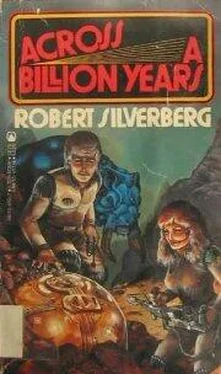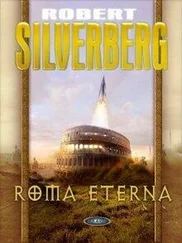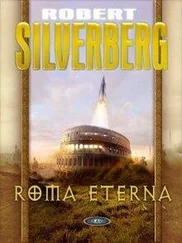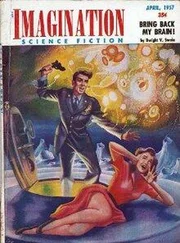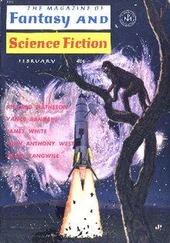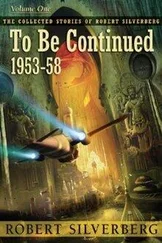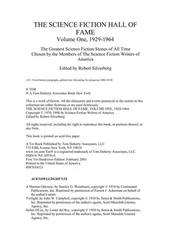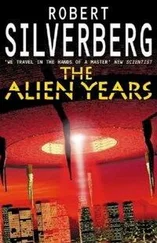Why am I on Dr. Schein’s side, you ask? How can I be on anybody’s side when we don’t really know a thing?
Simple. You know I have a romantic streak, Lorie. Otherwise I wouldn’t be out here doing what I’m doing, in defiance of my father’s notions of what I should be making out of my life. And so I automatically incline toward the theory that lights the most lights in my imagination.
If the High Ones did originate someplace within a hundred light-years of Earth, they have to be extinct now. If they still existed we’d certainly have bumped into them by this time.
If they came from some other galaxy, though, they may still be thriving out there somewhere. I like to think that they are. A race that can last a few hundred million years without blowing itself up — and we know that they lasted at least that long — can probably be considered just about immortal, as races go. And so, if Dr. Schein’s ideas are correct, it’s at least possible that the High Ones inhabit some other galaxy, living in all their ancient splendor, and that we may some day stumble upon them, who knows where? The Magellanic Clouds, M31 in Andromeda, the spiral galaxy Ml04 in Virgo, anywhere.
Let me quickly add that neither Dr. Schein nor any other reputable archaeologist has suggested that the High Ones still survive. A billion years is a long time even for a civilization of superbeings to endure. It is strictly my own wild notion that they linger on. The night I took my walk with Jan, I let a little of this emerge, and she was appalled.
“Nothing lasts a billion years, Tom!”
“You’re judging by Earth standards. Just because we’re newcomers to the universe, that doesn’t mean—”
“But there isn’t any intelligent race anywhere that’s remotely that old!” she protested. “The Shilamakka are about the oldest race in the galaxy, aren’t they? And they evolved only about fifty million years ago. Whereas our own species doesn’t even go back half a million years. And the Calamorians are even newer, and—”
“We have proof that the High Ones were able to survive across a span of 250 million years, Jan. So we know they had staying power. They could very well still—”
“What about evolutionary changes? In a billion years they’d have evolved out of all recognition!”
“Don’t you think they could control their own genetic flow?” I asked. “A conservative race like that wouldn’t allow random mutations. They’d keep themselves intact and unchanging.”
“And what about the natural resources of their home planet? Wouldn’t those have been exhausted long ago?”
“Who says they’re still living on their original planet?”
Jan wasn’t convinced. I have to confess that I wasn’t, either. The thought that one species can keep a civilization running for as much as a million years is more than an Earthborn type like me can comprehend. To talk about survival over a billion years — it sposhes the mind just to imagine it.
And yet — Lorie, I want them still to be out there somewhere. I can’t bear to believe that such greatness could ever have come to an end and vanished from the universe. The last of the High Ones, the death of a civilization millions of years old, no momentum left, cultural exhaustion, maybe — I reject it. Perhaps because to accept the passing of the High Ones means to accept the passing of Earthman culture some day. None of us ever believes in the possibility of his own death. Certainly not in the death of his species, his civilization. And if I believe in the immortality of the human race, as I can’t help doing, how can I believe that this much greater race of High Ones could have been mortal? No. I tell myself that they cling to existence far from here, in another galaxy, even though they may have forgotten how at one time they visited a neighboring galaxy where intelligent life hadn’t yet evolved. Ours.
There. That’s your chimpo brother talking, handing out the same sort of zooby romanticism that he always peddled. You used to tell me that I didn’t have the true scientific attitude of objectivity. Maybe you were right.
* * *
I see that I haven’t managed to say much about what we’ve accomplished here so far.
The basic thing about working at High Ones sites is that they’re so fantastically old that the usual techniques of archaeology can’t be applied. We’re paleo-archaeologists rather than archaeologists. We can’t just clear sand or dirt out of a site, the way the boys do on a dig in Egypt or New Mexico, and start hauling up artifacts. Over a billion years sand or dirt turn to stone. We have to carve all our finds out of solid rock.
For this we can use standard methods, up to a point. We clear away overburdens of soil with power shovels, with hand tools, and with bulldozers, including Dinamonians like Mirrik. When the heart of the site is exposed, though, we have to use vacuum-corers. These peel the rock away literally a molecule at a time, laying bare the artifacts we’re after. If your vacuum-corer operator is a little on the spinless side, he’s likely to chew up a few molecules of the artifact too, before he can stop.
So far Kelly has been just about perfect. She did cut into one very minor deposit, but that’s forgivable; otherwise she’s stripped the site with real skill. I take back all the stuff I was saying in the first cube about the inadequacies of an android vacuum-corer operator.
It took the better part of a week to get rid of the overburden, and another few days passed before we began to hit artifacts. This site is the biggest High Ones camp ever discovered, running for more than a hundred meters into the hillside. At this point we have collected a lot of standard stuff, debris discarded around the periphery of the camp, such things as —
?Inscription nodes. These are plastic tubes, about the size and shape of a cigar, usually deep green in color but sometimes blue. Along one side they bear an inscription in High Ones hieroglyphics, customarily consisting of seventy-five to a hundred symbols. At unpredictable intervals the inscriptions fade and new ones appear. This may happen when we hand a tube to someone else, when we tilt it, when the person holding it undergoes a sudden change of mood, or when it starts or stops raining. On the other hand, sometimes it is impossible to induce any change in the inscription even when all of these things occur simultaneously. Hundreds of inscription nodes have been uncovered at each High Ones site. Some have been opened; they have no moving parts and appear to be solid plastic all the way through. We understand what makes the inscriptions come and go about as thoroughly as a Neanderthal would understand where a television image comes from. We also are unable to decipher the inscriptions.
?Commemorative plaques. These are medals of some sort, about the size of large coins and stamped from some rustproof white metal. Heaps of them litter all High Ones sites. On one side they bear the image of what we assume is a High One: a humanoid creature with four arms, two legs, and a dome-shaped head. On the reverse side is an inscription in the same symbols found on the nodes. The melting point of the metal used in these plaques is upward of 3500 degrees; the metal is so extraordinarily hard that we don’t see how it could have been stamped. Chemical analysis has not revealed the nature of the alloy used.
?Puzzle-boxes. Just as the name implies: these are interlocking sheets of metal arranged in a variosity of disturbing patterns. The simplest ones are moebius strips, which are just flat lengths of metal with a twist in the middle and the ends joined, so that you can run your finger along one side, keep going past the twist, and end up on the other side without ever having lifted your finger. That is, the moebius strip is truly two-dimensional, since it only has one side. Okay? Then there are klein bottles, which are three-dimensional containers that loop back on themselves so that they also have just one surface. Also there are tesser-acts, which are structures with four spatial dimensions — a tesseract is to a cube as a cube is to a square, yes? If you look at a tesseract the right way, you’ll understand, but I don’t recommend trying. And then there are puzzle-boxes that don’t fit any mathematical theory, that fit together in odd ways so that you can trace a path down one side, and up another, and then you come to a place where the surface disappears and you’re somewhere else. About a dozen different kinds of puzzle-boxes are known. Maybe the High Ones used them for intellectual amusement. There are plenty of them here, in surprisingly good shape.
Читать дальше
